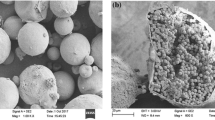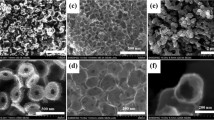Abstract
The work reported the preparation of hierarchically porous carbons (HPCs) with adjustable pore architectures using high internal phase emulsion (HIPE) template with the presence of polyaniline-coated carbon nanotubes (PANI-CNTs). PANI-CNTs were obtained via in situ polymerization of aniline in CNT suspension as confirmed by scanning electron microscope (SEM) and thermogravimetric analysis (TGA). Porous polydivinylbenzene (PDVB) monoliths were prepared by polymerizing the continuous phase of HIPE with PANI-CNTs dispersed in the internal phase. After carbonization and activation, HPCs with variable pore architectures were obtained. As observed by SEM, the PANI-CNTs showed notable influence on the pore architectures of PDVBs and HPCs. The void size of PDVB precursor reduced with the increase of the mass ratio of PANI to CNT, as well as the content of PANI-CNTs. Nitrogen adsorption/desorption measurements indicated the coexistence of mesopores and micropores, namely, hierarchical pores. The specific surface area (SSA) of HPC increased along with the content of PANI-CNTs from 1893 to 2392 m2/g. The capability of HPCs as the electrode material of supercapacitor was evaluated via electrochemical tests. The results indicated that the HPC with optimized pore architecture showed a higher specific capacitance (168.6 F/g) than the contrast sample (130.9 F/g) at 1 A/g. The better capacitance performance of HPC obtained with the presence of PANI-CNTs could be attributed to the reasonable hierarchical pores, higher SSA, and higher graphitization degree.











Similar content being viewed by others
References
Kim B-H, Yang KS, Woo H-G (2011) Thin, bendable electrodes consisting of porous carbon nanofibers via the electrospinning of polyacrylonitrile containing tetraethoxy orthosilicate for supercapacitor. Electrochem Commun 13(10):1042–1046. https://doi.org/10.1016/j.elecom.2011.06.024
L-b J, X-z Y, Liang J, Zhang J, Wang H, G-m Z (2016) Nanostructured core-shell electrode materials for electrochemical capacitors. J Power Sources 331:408–425. https://doi.org/10.1016/j.jpowsour.2016.09.054
Woodward RT, Markoulidis F, De Luca F, Anthony DB, Malko D, McDonald TO, Shaffer MSP, Bismarck A (2018) Carbon foams from emulsion-templated reduced graphene oxide polymer composites: electrodes for supercapacitor devices. J Mater Chem A 6(4):1840–1849. https://doi.org/10.1039/c7ta09893f
Hu B, Qin X, Asiri AM, Alamry KA, Al-Youbi AO, Sun X (2013) Synthesis of porous tubular C/MoS2 nanocomposites and their application as a novel electrode material for supercapacitors with excellent cycling stability. Electrochim Acta 100:24–28. https://doi.org/10.1016/j.electacta.2013.03.133
Kim SY, Kim B-H, Yang KS, Oshida K (2012) Supercapacitive properties of porous carbon nanofibers via the electrospinning of metal alkoxide-graphene in polyacrylonitrile. Mater Lett 87:157–161. https://doi.org/10.1016/j.matlet.2012.07.093
Kim B-H, Yang KS, Woo H-G (2012) Physical and electrochemical studies of polyphenylsilane-derived porous carbon nanofibers produced via electrospinning. Electrochim Acta 59:202–206. https://doi.org/10.1016/j.electacta.2011.10.057
Li Q, Xu Y, Zheng S, Guo X, Xue H, Pang H (2018) Recent Progress in some amorphous materials for supercapacitors. Small 14(28):e1800426. https://doi.org/10.1002/smll.201800426
Xie S, Liu S, Cheng F, Lu X (2018) Recent advances toward achieving high-performance carbon-fiber materials for supercapacitors. ChemElectroChem 5(4):571–582. https://doi.org/10.1002/celc.201701020
Liu T, Zhang F, Song Y, Li Y (2017) Revitalizing carbon supercapacitor electrodes with hierarchical porous structures. J Mater Chem A 5(34):17705–17733. https://doi.org/10.1039/c7ta05646j
Bandosz TJ, Ren T-Z (2017) Porous carbon modified with sulfur in energy related applications. Carbon 118:561–577. https://doi.org/10.1016/j.carbon.2017.03.095
Borghei M, Laocharoen N, Kibena-Poldsepp E, Johansson L-S, Campbell J, Kauppinen E, Tammeveski K, Rojas OJ (2017) Porous N,P-doped carbon from coconut shells with high electrocatalytic activity for oxygen reduction: alternative to Pt-C for alkaline fuel cells. Applied Catalysis B-Environmental 204:394–402. https://doi.org/10.1016/j.apcatb.2016.11.029
Chen Y, Ji S, Wang Y, Dong J, Chen W, Li Z, Shen R, Zheng L, Zhuang Z, Wang D, Li Y (2017) Isolated single Iron atoms anchored on N-doped porous carbon as an efficient electrocatalyst for the oxygen reduction reaction. Angewandte Chemie-International Edition 56(24):6937–6941. https://doi.org/10.1002/anie.201702473
Zhang C, Kong R, Wang X, Xu Y, Wang F, Ren W, Wang Y, Su F, Jiang J-X (2017) Porous carbons derived from hypercrosslinked porous polymers for gas adsorption and energy storage. Carbon 114:608–618. https://doi.org/10.1016/j.carbon.2016.12.064
Bhadra BN, Lee JK, Cho C-W, Jhung SH (2018) Remarkably efficient adsorbent for the removal of bisphenol A from water: bio-MOF-1-derived porous carbon. Chem Eng J 343:225–234. https://doi.org/10.1016/j.cej.2018.03.004
Du W, Xu Q, Zhan R, Zhang Y, Luo Y, Xu M (2018) Synthesis of hollow porous carbon microspheres and their application to room-temperature Na-S batteries. Mater Lett 221:66–69. https://doi.org/10.1016/j.matlet.2018.03.090
Kim B-H, Yang KS, Woo H-G, Oshida K (2011) Supercapacitor performance of porous carbon nanofiber composites prepared by electrospinning polymethylhydrosiloxane (PMHS)/polyacrylonitrile (PAN) blend solutions. Synth Met 161(13–14):1211–1216. https://doi.org/10.1016/j.synthmet.2011.04.005
Yang W, Yang W, Song A, Gao L, Su L, Shao G (2017) Supercapacitance of nitrogen-sulfur-oxygen co-doped 3D hierarchical porous carbon in aqueous and organic electrolyte. J Power Sources 359:556–567. https://doi.org/10.1016/j.jpowsour.2017.05.108
Hu W, Xie F, Li Y, Wu Z, Tian K, Wang M, Pan L, Li L (2017) Hierarchically porous carbon derived from polyHIPE for supercapacitor and deionization applications. Langmuir 33(46):13364–13375. https://doi.org/10.1021/acs.langmuir.7b03175
Israel S, Gurevitch I, Silverstein MS (2015) Carbons with a hierarchical porous structure through the pyrolysis of hypercrosslinked emulsion-templated polymers. Polymer 72:453–463. https://doi.org/10.1016/j.polymer.2015.02.055
Cohen N, Silverstein MS (2011) Synthesis of emulsion-templated porous polyacrylonitrile and its pyrolysis to porous carbon monoliths. Polymer 52(2):282–287. https://doi.org/10.1016/j.polymer.2010.11.026
Gross AF, Nowak AP (2010) Hierarchical carbon foams with independently tunable mesopore and macropore size distributions. Langmuir 26(13):11378–11383. https://doi.org/10.1021/la1007846
Wang C, Wu D, Wang H, Gao Z, Xu F, Jiang K (2018) Biomass derived nitrogen-doped hierarchical porous carbon sheets for supercapacitors with high performance. J Colloid Interface Sci 523:133–143. https://doi.org/10.1016/j.jcis.2018.03.009
Yang W, Hou L, Xu X, Li Z, Ma X, Yang F, Li Y (2018) Carbon nitride template-directed fabrication of nitrogen-rich porous graphene-like carbon for high performance supercapacitors. Carbon 130:325–332. https://doi.org/10.1016/j.carbon.2018.01.032
Zhu SY, Tian H, Wang N, Chen B, Mai YY, Feng XL (2018) Patterning graphene surfaces with Iron-oxide-embedded mesoporous polypyrrole and derived N-doped carbon of tunable pore size. Small 14(9). https://doi.org/10.1002/smll.201702755
Tian H, Zhu SY, Xu FG, Mao WT, Wei H, Mai YY, Feng XL (2017) Growth of 2D mesoporous polyaniline with controlled pore structures on ultrathin MoS2 nanosheets by block copolymer self-assembly in solution. ACS Appl Mater Interfaces 9(50):43975–43982. https://doi.org/10.1021/acsami.7b13666
Tian H, Lin ZX, Xu FG, Zheng JX, Zhuang XD, Mai YY, Feng XL (2016) Quantitative control of pore size of mesoporous carbon nanospheres through the self-assembly of diblock copolymer micelles in solution. Small 12(23):3155–3163. https://doi.org/10.1002/smll.201600364
Woodward RT, Fam DWH, Anthony DB, Hong J, McDonald TO, Petit C, Shaffer MSP, Bismarck A (2016) Hierarchically porous carbon foams from Pickering high internal phase emulsions. Carbon 101:253–260. https://doi.org/10.1016/j.carbon.2016.02.002
Deshmukh AB, Nalawade AC, Karbhal I, Qureshi MS, Shelke MV (2018) Electrochemical capacitive energy storage in polyHIPE derived nitrogen enriched hierarchical porous carbon nanosheets. Carbon 128:287–295. https://doi.org/10.1016/j.carbon.2017.11.080
Woodward RT, Jobbe-Duval A, Marchesini S, Anthony DB, Petit C, Bismarck A (2017) Hypercrosslinked polyHIPEs as precursors to designable, hierarchically porous carbon foams. Polymer 115:146–153. https://doi.org/10.1016/j.polymer.2017.03.042
Kapilov-Buchman K, Portal L, Zhang Y, Fechler N, Antonietti M, Silverstein MS (2017) Hierarchically porous carbons from an emulsion-templated, urea-based deep eutectic. J Mater Chem A 5(31):16376. https://doi.org/10.1039/c7ta01958k
Senthil Raja D, Luo JH, Chang TG, Lo SH, Wu CY, Lin CH (2013) Synthesis, crystal structure, and luminescence properties of a new calcium(II) coordination polymer based on L-malic acid. J Chem 2013:1–7. https://doi.org/10.1007/s00396-019-04594-3
Bai Q, Xiong Q, Li C, Shen Y, Uyama H (2018) Hierarchical porous carbons from a sodium alginate/bacterial cellulose composite for high-performance supercapacitor electrodes. Appl Surf Sci 455:795–807. https://doi.org/10.1016/j.apsusc.2018.05.006
Sun F, Gao J, Pi X, Wang L, Yang Y, Qu Z, Wu S (2017) High performance aqueous supercapacitor based on highly nitrogen doped carbon nanospheres with unimodal mesoporosity. J Power Sources 337:189–196. https://doi.org/10.1016/j.jpowsour.2016.10.086
Wang Y, Fugetsu B, Wang Z, Gong W, Sakata I, Morimoto S, Hashimoto Y, Endo M, Dresselhaus M, Terrones M (2017) Nitrogen-doped porous carbon monoliths from polyacrylonitrile (PAN) and carbon nanotubes as electrodes for supercapacitors. Sci rep 7. https://doi.org/10.1038/srep40259
Zhang Z, Wang L, Li Y, Wang Y, Zhang J, Guan G, Pan Z, Zheng G, Peng H (2017) Nitrogen-doped core-sheath carbon nanotube array for highly stretchable supercapacitor. Adv Energy Mater 7(5). https://doi.org/10.1002/aenm.201601814
Lin Z, Xiang XT, Peng SJ, Jiang XC, Hou LX (2018) Facile synthesis of chitosan-based carbon with rich porous structure for supercapacitor with enhanced electrochemical performance. J Electroanal Chem 823:563–572. https://doi.org/10.1016/j.jelechem.2018.06.031
Lin Z, Xiang XT, Chen K, Peng SJ, Jiang XC, Hou LX (2019) Facile synthesis of MnO2 nanorods grown on porous carbon for supercapacitor with enhanced electrochemical performance. J Colloid Interface Sci 540:466–475. https://doi.org/10.1016/j.jcis.2019.01.053
Kim H, Ahn KH, Lee SJ (2017) Conductive poly(high internal phase emulsion) foams incorporated with polydopamine-coated carbon nanotubes. Polymer 110:187–195. https://doi.org/10.1016/j.polymer.2017.01.007
Wang M, Liu H, Zhai DD, Chen XY, Zhang ZJ (2019) In-situ synthesis of highly nitrogen, sulfur co-doped carbon nanosheets from melamine-formaldehyde-thiourea resin with improved cycling stability and energy density for supercapacitors. J Power Sources 416:79–88. https://doi.org/10.1016/j.jpowsour.2019.01.092
Chen YX, Shen M, Fu X, Yao HC, Zhang XM, Liu YQ, Liu XY, Yao KX (2019) Enhancing supercapacitive performance of hierarchical carbon by introducing extra-framework cations. Mater Lett 253:416–419. https://doi.org/10.1016/j.matlet.2019.07.072
Zhao YL, Zhao Z, Zhang J, Wei MZ, Xiao LQ, Hou LX (2018) Distinctive performance of gemini surfactant in the preparation of hierarchically porous carbons via high-internal-phase emulsion template. Langmuir 34(40):12100–12108. https://doi.org/10.1021/acs.langmuir.8b02562
Shi K, Ren M, Zhitomirsky I (2014) Activated carbon-coated carbon nanotubes for energy storage in supercapacitors and capacitive water purification. ACS Sustain Chem Eng 2(5):1289–1298. https://doi.org/10.1021/sc500118r
Lee MS, Whang DR, Song YH, Kim JT, Yang MH, Choi UH, Chang DW (2019) Effects of pyridine and pyrrole moieties on supercapacitive properties of imine-rich nitrogen-doped graphene. Carbon 152:915–923. https://doi.org/10.1016/j.carbon.2019.06.082
Peng H, Ma GF, Sun KJ, Zhang ZG, Yang Q, Lei ZQ (2016) Nitrogen-doped interconnected carbon nanosheets from pomelo mesocarps for high performance supercapacitors. Electrochim Acta 190:862–871. https://doi.org/10.1016/j.electacta.2015.12.195
Hao XD, Wang J, Ding B, Wang Y, Chang Z, Dou H, Zhang XG (2017) Bacterial-cellulose-derived interconnected meso-microporous carbon nanofiber networks as binder-free electrodes for high-performance supercapacitors. J Power Sources 352:34–41. https://doi.org/10.1016/j.jpowsour.2017.03.088
Ma GF, Li JD, Sun KJ, Peng H, Feng EK, Lei ZQ (2017) Tea-leaves based nitrogen-doped porous carbons for high-performance supercapacitors electrode. J Solid State Electrochem 21(2):525–535. https://doi.org/10.1007/s10008-016-3389-y
Sun KJ, Li JD, Peng H, Feng EK, Ma GF, Lei ZQ (2017) Promising nitrogen-doped porous nanosheets carbon derived from pomegranate husk as advanced electrode materials for supercapacitors. Ionics 23(4):985–996. https://doi.org/10.1007/s11581-016-1897-5
Funding
Thanks to the programs including the National Natural Science Foundation of China (no. 51703030), Natural Science Foundation of Fujian province (2017 J01695), National Natural Science Foundation of China (nos. 21676057and 21504025), and Program for New Century Excellent Talents in Fujian Province University (NCETFJ) for the financial supports.
Author information
Authors and Affiliations
Corresponding authors
Ethics declarations
Conflict of interest
There are no conflicts of interest.
Additional information
Publisher’s note
Springer Nature remains neutral with regard to jurisdictional claims in published maps and institutional affiliations.
Electronic supplementary material
ESM 1
(PDF 701 kb)
Rights and permissions
About this article
Cite this article
Zhao, Y., Zhang, J., Wei, M. et al. Tuning the pore architectures of hierarchically porous carbons from high internal phase emulsion template by polyaniline-coated CNTs. Colloid Polym Sci 298, 179–191 (2020). https://doi.org/10.1007/s00396-019-04594-3
Received:
Revised:
Accepted:
Published:
Issue Date:
DOI: https://doi.org/10.1007/s00396-019-04594-3




